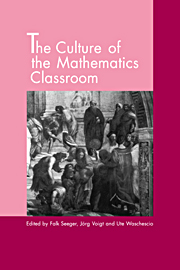Book contents
- Frontmatter
- Contents
- List of contributors
- Acknowledgments
- Introduction
- Part I Changing classroom culture
- 1 Joint activity in mathematics classrooms: A Vygotskian analysis
- 2 Evolution of classroom culture in mathematics, teacher education, and reflection on action
- 3 Reorganizing the motivational sphere of classroom culture: An activity-theoretical analysis of planning in a teacher team
- 4 The practice of teaching mathematics: Experimental conditions of change
- Part II Classroom processes
- Part III Epistemology and classroom culture
- Part IV Outlook
- Author index
- Subject index
3 - Reorganizing the motivational sphere of classroom culture: An activity-theoretical analysis of planning in a teacher team
Published online by Cambridge University Press: 03 May 2010
- Frontmatter
- Contents
- List of contributors
- Acknowledgments
- Introduction
- Part I Changing classroom culture
- 1 Joint activity in mathematics classrooms: A Vygotskian analysis
- 2 Evolution of classroom culture in mathematics, teacher education, and reflection on action
- 3 Reorganizing the motivational sphere of classroom culture: An activity-theoretical analysis of planning in a teacher team
- 4 The practice of teaching mathematics: Experimental conditions of change
- Part II Classroom processes
- Part III Epistemology and classroom culture
- Part IV Outlook
- Author index
- Subject index
Summary
The culture of the classroom has been found to be an extraordinarily uniform and persistently stable formation (Cuban 1984). Numerous attempts at school reform seem to have produced relatively few lasting effects (Sarason 1990). Tharp and Gallimore (1988) suggest that this is because school reforms have remained at the level of systems and structures, not reaching the daily practices of teaching and learning in classrooms. On the other hand, attempts to change the daily instructional practices, such as the program designed by Tharp and Gallimore themselves, have not been particularly successful in the long run either.
The dichotomy of systems and structures, on the one hand, and daily classroom practices, on the other hand, may itself be an important reason for the difficulties. These two levels are explicit – one is codified on laws, regulations, and budgets, the other is codified in curricula, textbooks, and study materials. There is, however, a middle level between the formal structure of school systems and the content and methods of teaching. The middle level consists of relatively inconspicuous, recurrent, and taken-for-granted aspects of school life. These include grading and testing practices, patterning and punctuation of time, uses (not contents) of textbooks, bounding and use of the physical space, grouping of students, patterns of discipline and control, connections to the world outside the school, and interaction among teachers as well as between teachers and parents. This middle level has been called “hidden curriculum” (Snyder 1971; see also Henry 1963; Holt 1964; for a recent powerful account of one version of “hidden curriculum,” see Høeg 1994).
- Type
- Chapter
- Information
- The Culture of the Mathematics Classroom , pp. 76 - 103Publisher: Cambridge University PressPrint publication year: 1998
- 38
- Cited by



